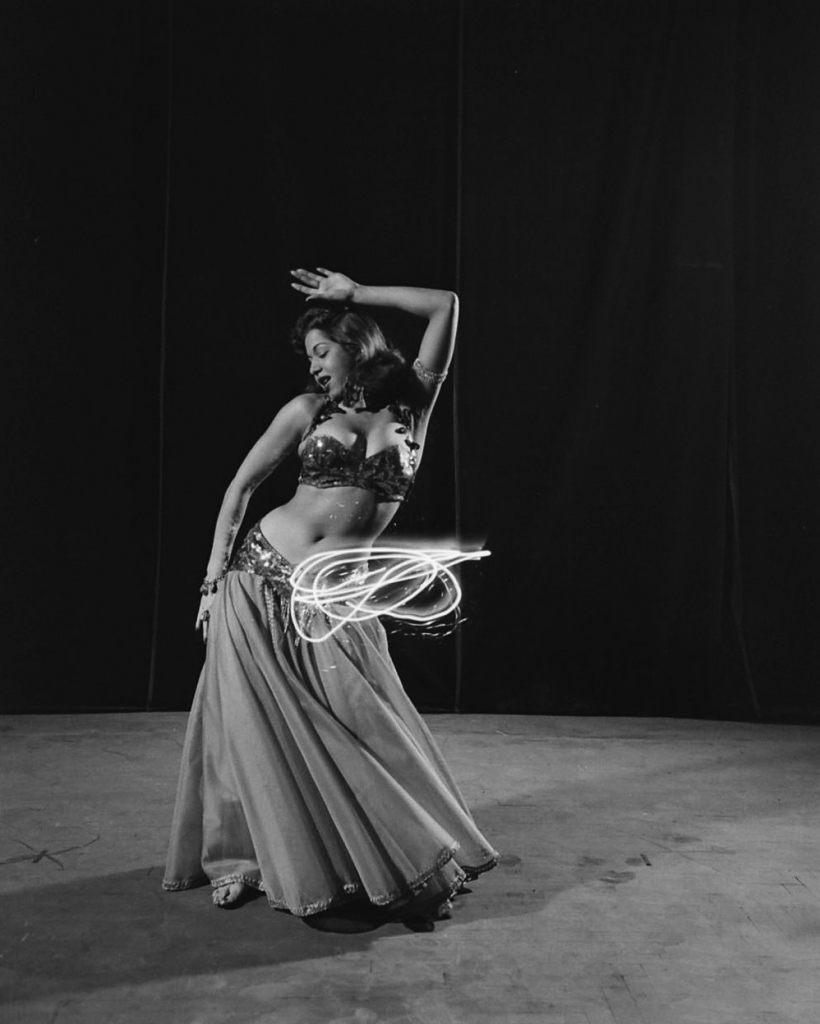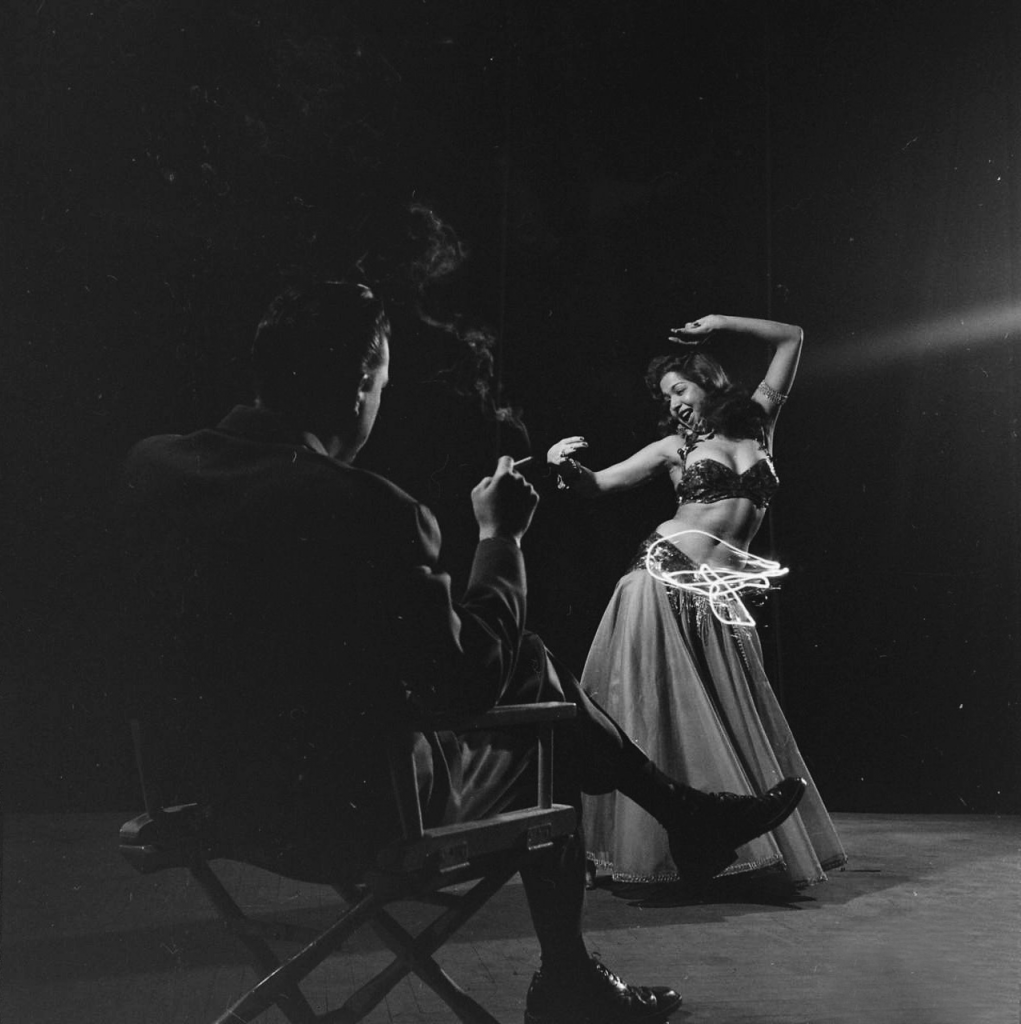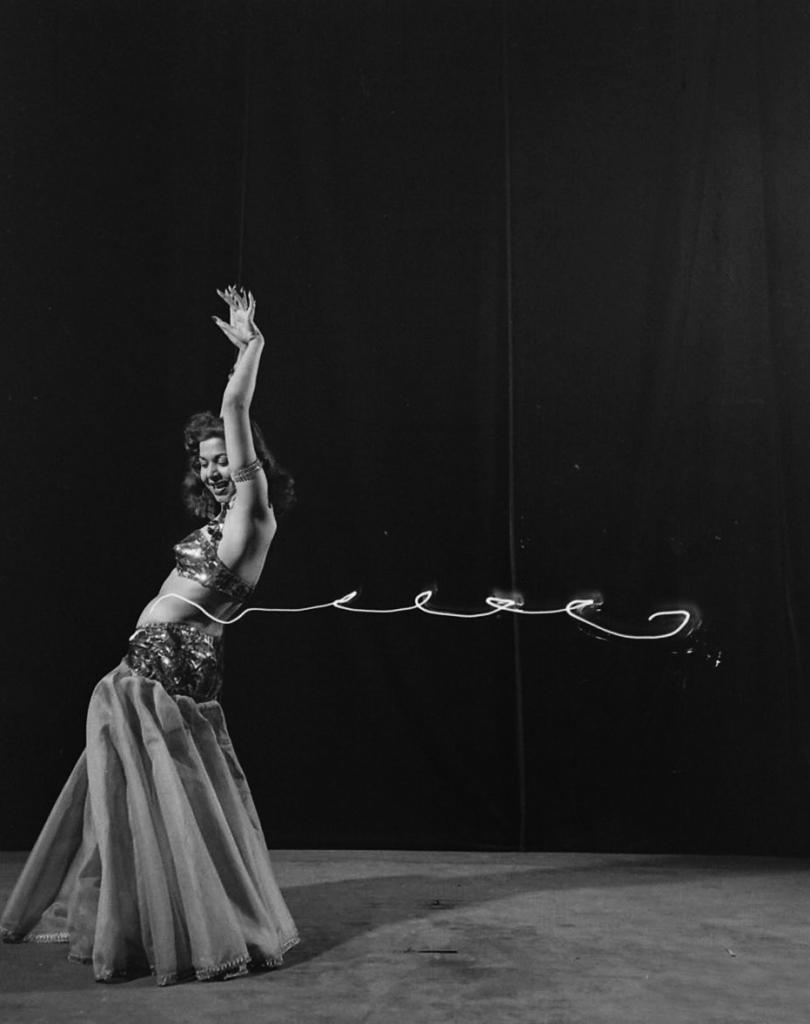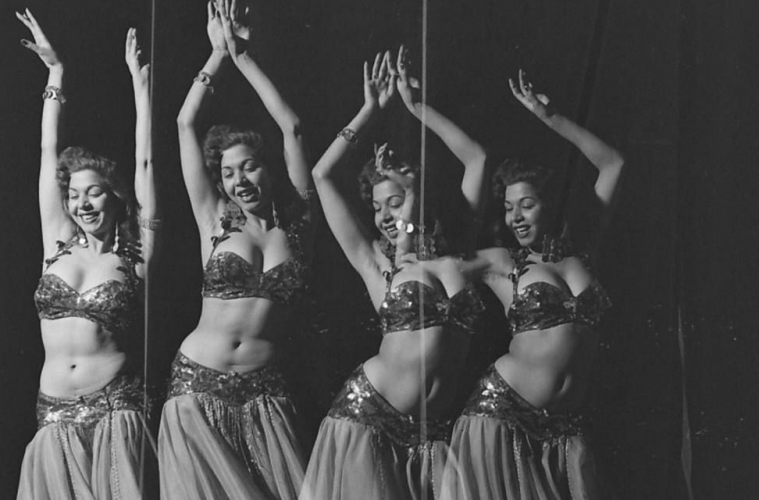بالعربي
Words by Badr Sellak
Images: Samia Gamal photographed by Loomis Dean, at The Latin Quarter Club, New York, 1952
This article is part of the “Ya Leil Ya Eyein” issue
Belly dancing has seen both revival and deep crisis over the past few decades. Brought on in part by increased commercial success, belly dancing has been celebrated as a typical erotic and “authentically Arabian” cultural form, but one that is a reductive representation or simplistic signifier for an idea that never comes into view. Like the scantily clad concubines of Rochegrosse and Chasseriau’s harem paintings, the figure of the belly dancer in Egyptian cinema makes us ask how “the Orient” is represented erotically, often through reductive portrayals of the Arabian erotic. How does “sexy” translate into Arabic? How did the Arabian erotic come to be depicted almost solely in the context of belly dancing? And how has the belly dancer become diluted into a nostalgic icon?
As a primary force for engaging the social imaginary of much of the Arab world, Egyptian cinema has been a main vehicle in solidifying notions of sensuality and eroticism in cultural memory. Early Egyptian cinema played a huge role in normalizing the figure of the belly dancer as a recognizable cinematic trope and aesthetic device, an element of creative choice and art direction rather than a product of folklore or traditional art.
The success of Badia Massabni’s first dancing films, including Queen of the Theaters (Volpe, 1936), led to a proliferation of the dance film genre that pulled from a variety of music traditions from cabarets to folk, making dance “an almost inevitable feature of most films.”1 Films like Leila (Mizrahi, 1942), Les Miserables (Selim, 1944), and A Woman’s Youth (Abou Seif, 1956) helped solidify a model of the belly dancer as a gold-hearted seductress with the femme fatale mystique, an object of raw desire to be worshiped and veneered by the agape onlookers. She is an enchanting figure oscillating between realities, and a goddess among mortals in the nocturnal enclaves of disenfranchised communities.

The story behind the light coming from Samia Gamal’s hips: photographer Loomis Dean attached a flashlight bulb To Samia’s skirt, just below her navel and strung wires around her hips to two tiny batteries. Then he had her dance in a dark room, opened his shutter for a time exposure so that only the flashlight patterns were recorded on film, finally flashed a strobe light to catch the rest of Samia. Samia Gamal photographed by Loomis Dean, at The Latin Quarter Club, New York, 1952.
The reverberations of these artifacts demonstrate the extent of cinema’s influence in the 20th century. Egyptian cinema managed to take an otherwise communal and socio-cultural practice and distill it into a recognizable icon of the belly dancer. However, her role was not always fixed; it developed from a generic love interest in early films to an almost unreal figure who could capture desire and inspire admiration in a fictional world that was as much everyday as folklore.
Though belly dancing had existed as a celebratory communal practice and in seedy bars and cabarets prior its uptake in Egyptian cinema, Arabian culture did not previously have a strong tradition of depicting visual erotica. This is one reason that the sex appeal of the belly dancer iconized in film came to index the Arabian erotic on the whole, an equivelent to a blonde and voluptuous playmate in the West.
As Arabian cinema contributed to normalizing depictions of belly dancing as an index of the Arabian erotic aesthetic and experience, it did so in culturally-specific ways. One way that classic Egyptian films from the 1950s to the 1970s conveyed the Arabian eroticis with loosely form fitting robes, summer dresses and flared djellabas that elicited a sensitivity for the shape and form behind loose fabric. Even belly dancers who wear little tie a piece of cloth or a scarf around the midriff, a recurrent sign in most “Oriental” cultures. Though this type erotic imagery was short-lived before it gave way to a more “modern aesthetic,” it still occupies a significant place in Arabian cultural memory and allows us to see the erotic side in the everyday attire seen in homes and on the sreets of Arabian cities.
Not surprisingly, there is an atemporal element attached to this representation, which is maintained in part through traditions of belly dancing performance. It comes to represent the authentic or traditional (baladi) aesthetic that exists in contrast to the contemporary.

Samia Gamal dancing in front of her husband then Texas heir, Sheppard King III. Photographed by Loomis Dean, at The Latin Quarter Club, New York, 1952.
Belly dancing is now common across Arabian commercial films and music videos, but it is only an aesthetic choice reminiscent of the past in these contemporary iterations. Since a shift in the 1970s toward a modern sex icon clothed in office attire and skin boots, the belly dancer has been rendered a static timepiece. This transformation has foreclosed exploration of the practice and stripped it of its significance, a process which has been further accelerated by commodification.
The figure of the belly dancer also continues to be appropriated into Western films and imagery, often romanticized under an orientalist gaze. Anthony Shay and Barbara Sellers-Young write that, “Sheiks, slave girls, veils, harems filled with scantily clad beauties […] are familiar images in moving pictures,” and that, “terms such as ‘allure’ and ‘mystique’ abound in advertisements and articles in belly dance publications.”2 Like other commodified cultural forms, from Gnawa and traditional tapestries to architecture and mosaics, depictions of belly dancing are both decontextualized and frozen in time. It was treated as a novelty or something “other worldly” as it was appropriated in a variety of off-screen spaces in the West in the 60s, including cabarets, night clubs, parties, and restaurants, and practitioners of oriental dance often go as far as to take romanticized Arabesque names.
“Belly Dance” has become an umbrella term encompassing a variety of styles. This, in addition to the resulting reductive imagery that reifies the binary between the “crude oriental/Arabian aesthetic” and “modern contemporary” aesthetic (implicitly influenced by Western cultures), shows how media and commercialization can radically alter culture and cultural history. This trend has only intensified as belly dancing has gained more recognition globally and become increasingly part of a shared virtual space wherein cultural forms are broken down and stripped of their aesthetic idiosyncrasies.
Breaking the relation between cultural practice and any sense of locality, belly dancing is reduced to something that can be easily conceptualized, universalized, and interchanged in the public domain. G.M. Hernàndez i Martí refers to this as deterritorialization, a process that “speaks of the loss of the ‘natural’ relation between culture and the social and geographic territories,” and “describes a deep transformation of the link between our everyday cultural experiences and our configuration as preferably local beings.” Thus, this process “generates benefit, but also produces evident costs such as feelings of existential vulnerability or of cultural rootlessness.”3
Thus, the vestiges of belly dancing we see in today’s media are mere reappearances. This is the death of a cultural form. It isn’t only the loss of this sense of geographical and social unity that caused it’s death; it’s that the singular notion of what belly dancing is only became in retrospect and as the result of a series of contests for power that continue to haunt us in the present.
Throughout most of modern history, belly dancing has been part of a debate on what a moral society looks like. It has inconvenienced authorities who have tried to regulate it, turn it into a “legitimate profession,” or banish it completely. Belly dance was considered the eye sore in an otherwise perfect image of a vice-free and symbolically complete society. It operated as an agent of chaos to what constituted this notion for most Arabian communities.
Authorities’ attempts to restrict belly dancing are part of a broader project of disseminating these images of a kitsch-like society as a way of enforcing sociocultural norms and setting up a society of virtuous men and women. This project relies on an essential division between a “regular plane” that we can acknowledge on a cultural level, and an “underground plane” that must be banished, for that’s where the sordid aspects of life experience play out. But belly dancing hangs between these planes, representative of both folklore and tradition and of an underworld of decadence and decay.
This ongoing debate on belly dancing’s significance or ethical valence in cultural and political domains does not seem to affect the practice itself. Instead, it’s decontextualization and commodification that have transformed belly dancing from something of shock value and novelty into one of many exotic visual signs. It’s as if any social significance that belly dancing possessed — and the criticism it invokes on the nature of a virtuous society — has become obsolete. This process of decontextualization is an important one: its uptake in cinema gave it a place in a wider cultural discourse, and its integration into the international market of goods and ideas reduced it to merely aesthetic qualities. What is left is a residual or a “hauntology,”4 the persistence of an element of the past that is reintroduced into a new form.

Slithering forward, Samia’s light shows how she varies the ordinary human act of walking. Photographed by Loomis Dean, at The Latin Quarter Club, New York, 1952.
There is a crisis inherent in the revival of belly dancing and celebration of the Arabian erotic. If revival means to rediscover, re-imagine, and appreciate “dead” cultural forms and practices, then it is necessarily nostalgic. The revival of a cultural element or form is not only nostalgic but often describes commercial success, growing popularity around the world, variations and hybrid styles. What lies on the other side of this is a breakdown of the cultural form, deterritorialization of cultural practice, and acculturation? Can Arabian erotica move beyond simplistic representations of belly dance and the Orientalist gaze?
A wider revivalist movement in the independent Arabian art scene aims to do just this: they pay homage to the past, invoke appreciation for it, and adapt elements to show its relevance to the present5. Though these attempts have been received positively by galleries and currators, depictions of the sensual and erotic remain elusive for moral and/or religious reasons, but mostly due to the conceptual turn erotica has taken as of the last decades. And yet, these pieces (and even the idea of Arabian erotica) still reek of historical shortcomings.
What is the role of the the Arabian erotic and the cultural histories in this revivalist movement? Could its rediscovery, in addition to form, be the answer to its shortcoming? In essence, the function of revivalism of cultural practices is to resolve conflicts in these dead cultural forms. So, further diluting our understanding of belly dancing and Arabian erotica to simply its enjoyable aspects would be counter the ideal of the revivalist process. Instead, this dilution would function to dismantle the ‘dead cultural form’. However, should this rediscovery bring its complexity and history back into view, this could very well be the final frontier of contemporary Arabian art scenes.
- Galal El-Chakawi, “History of the U A R Cinema, 1869-1962”, in The Cinema of Arab Countries , ed. Georges Sadoul. (Beirut: Interlab Center of Cinema and Television, 1966), pages 69-97.
- Anthony Shay and Barbara Sellers-Young. “Belly Dance: Orientalism—Exoticism—Self-Exoticism.” Dance Research Journal 35, no. 1 (2003): 13–37.
- Gil-Manuel Hernàndez i Martí. “The deterritorialization of cultural heritage in a globalized modernity.” notes & comments, no. 1 (2006): 91-107. Quotes from pages 93-94.
- Peter Buse and Andrew Stott. 1999. “Introduction: a Future for Haunting”. In Ghosts: Deconstruction, Psychoanalysis, History, ed. Peter Buse and Andrew Stott (London: Palgrave, 1999): pages 1-20.
- See: Mona Trad Dabaji, Haifa (2008), Life is Beautiful (2006), and Nu au Sheh VII (2013); Laila Essaydi, Harem Revisited (2012); Yousef Nabil, Fifi with shisha, (2000) and I saved my Belly Dancer (2015)

